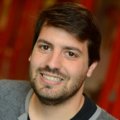 In this thesis Reverse Electrodialysis (RED) is central. A RED stack comprises of alternating series of cation exchange membranes (CEMs) and anion exchange membranes (AEMs), with seawater and river water compartments between these membranes.
In this thesis Reverse Electrodialysis (RED) is central. A RED stack comprises of alternating series of cation exchange membranes (CEMs) and anion exchange membranes (AEMs), with seawater and river water compartments between these membranes.
From the salinity gradient, energy is harvested while controlling the mixing of seawater and river water. Membranes allow selective transport of cations (CEM) and anions (AEM). A voltage difference is created due to the difference in salinity across the membrane. At the electrodes redox reactions are used, to convert ionic transport into electrical transport, to power a device.
‘We came up with creative strategies to prevent fouling,’ says Jordi Moreno. ‘The most high-profile idea concerned the concept of breathing cells. We brought this proof of principle - confirmed earlier in lab environments by dr. ir. David Vermaas – a decisive step further. The stack is now automatically operable which is practically relevant.’
In the breathing cell concept, instead of fixed compartment volumes between the membranes, the compartments can be dynamically changed by increasing the internal volume. This movement allows to adapt the operation to the water parameters and stack performance characteristics, e.g. fouling presence.
Jordi: ‘We have built a more automatic control flow device and tested it under process conditions at the RED stack Blue Energy research plant, located at Afsluitdijk, which is a national icon project. It made my PhD work even the more challenging, as one is able to perform upscaling experiments in a very early stage of research already.’
Jordi Moreno also is enthusiastic about the antifouling strategy using CO2-saturated water.
‘The major cause is fouling on the spacers,’ Jordi explains. ‘Fouling deposition disturbs the flow distribution. The CO2-saturated water combines two process mechanisms. The spontaneous formation of bubbles at the space filaments between the membranes, improves the cleaning process and contributes to a pH-drop in the system, creating an additional cleaning effect. This effect was already investigated in the Membrane Science and Technology department earlier, mainly intended for reverse osmosis processes. I brought it over successfully to the RED research field.’
Other research
Two other important research experiments involved humic acids (the major cause of fouling on anion exchange membranes) and the presence of multivalent ions (i.g. Mg2+, causing uphill transport, increasing the membrane resistance of the cation exchange membranes). Jordi: ‘In this thesis, we found that the membrane chemistry and the water content of the membranes, are key parameters to understand the effect of humic acids in our systems.’
As to multivalent ions, Jordi concluded that: a more open structure of the membranes provides the best long-term strategy, allowing the free movement of both sodium and magnesium ions through the membranes, avoiding them to be trapped within the membranes.
Future work
After his PhD research Jordi will work part-time at the Centre of Expertise Water Technology (CEW) in Leeuwarden. ‘In this extensive lab, we will perform contract research for companies and organisations from the social field,’ Jordi says. ‘The main aim is to scale up water treatment and other installations, to speed up and facilitate innovation. We do this together with students in Applied Sciences from Van Hall Larenstein and NHL University of Applied Sciences. I like the combination of project management, client contact and being active as a teacher and coach in education as well. It is a nice role to dance between industry and education.’
‘I will combine the job at CEW with my current job as R&D process technologist at REDstack. We are now facing a crucial step towards technology commercialization of Blue Energy with the Katwijk project. Here, we aim to scale-up the process towards a 1 MW installation. I look forward to my new life in Friesland.’
Skills
During his PhD project, Jordi spent most of his time at the Wetsus Centre for sustainable water technology. Jordi: ‘Especially the courses aimed at personal development, which were an integral part of the PhD project, I appreciated. I learned my strengths and limits in social situations and communication. Being a member of the Membrane Group within Mesa+ was extremely helpful, meeting all kinds of experts and colleagues with which we collaborated closely. It felt like having constant excess to the Wikipedia of knowledge of membranes.‘
